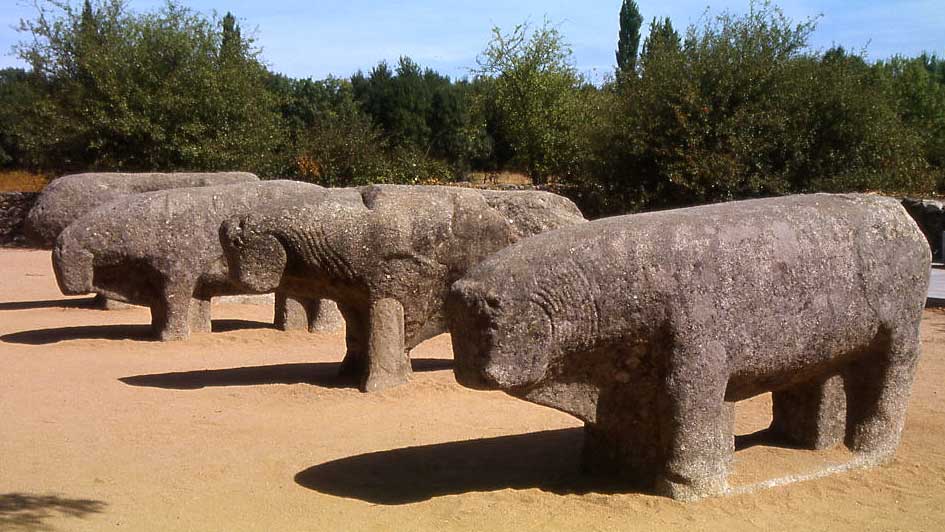Bulls of Guisando
Granite megalithic monuments of animals
Ávila province is probably best known for the mediaeval granite walls of its capital city, granted World Heritage status in 1985, but it is also here, in a province which now forms part of Castilla y León, that a Celtic people named by the Romans as the ‘Vettones’, have left their mark in the form of the ancient sculptures known as ‘verracos’.

CC BY-SA 3.0, https://commons.wikimedia.org/w/index.php?curid=738803
These granite megalithic monuments are sculptures of animals, generally pigs and bulls, which can be found across Ávila province, Salamanca and Zamora, and in parts of Portugal. There is also one, said to represent a bear, from which the Ávila village of El Oso has taken its name.
Others have been found in Extremadura and Segovia.
Some 400 are known to date, and the largest known example and one of the oldest in Europe is in the main square of Villanueva del Campillo, Ávila province, restored some years ago when its hindquarters were replaced with bronze. It could date as far back as the IV century BC and is one of more than 170 in the province.
Many of the ‘verracos’ have had their place in literature, including the verraco which stands beside the Roman bridge of Salamanca, immortalised in the anonymous novel ‘El Lazarillo de Tormes’ published during the Spanish Inquisition and said to be the founding novel of the picaresque genre. The 16th century novel tells how Lazarillo learnt a harsh lesson from his master, a blind man, as they crossed the Roman bridge together.
‘We left Salamanca and, arriving at the bridge, there is an animal of stone at the approach in the shape of a bull. The blind man ordered me to draw near the animal and, once there, said to me, “Lazaro, draw your ear to the bull and you will hear a great din from within”. ‘I stretched over simplemindedly, believing it to be so and, as he felt that I had my head next to the stone, he steadied it with his rough hand and dealt me a great blow against the devilish bull, which still hurt from the goring more than three days later, and said to me’: “Fool, you must learn that the servant of a blind man must be at the point of knowing more than the devil himself”.
Perhaps the best known sculptures of these Celt Iberian times are the Bulls of Guisando, four quadruped granite sculptures which stand side by side on the hill of Guisando in El Tiemblo in Ávila. They are mentioned a number of times in Cervantes ‘Don Quijote’, and hold their place in history with the Tratado de los Toros de Guisando, signed at a nearby location between Henry IV of Castilla and his half-sister, Isabela of Castilla, in 1468, recognising the future Catholic Queen as the Princess of Asturias and heir to the throne of Castile.
The bulls of Guisando are even mentioned in what many feel is the Granada poet, Federico García Lorca’s, finest poem, his ‘Lament for Ignacio Sánchez Mejías’, his bullfighter friend who was gored to death in 1934 and who was a friend of several members of the so-called Generation of ’27.
“The cow of this ancient world passed her dreary tongue over a soulful of blood spilled on the sand, and the bulls of Guisando, partly death and partly stone, bellowed with the weight of two centuries on their backs, tired of treading the earth”.
